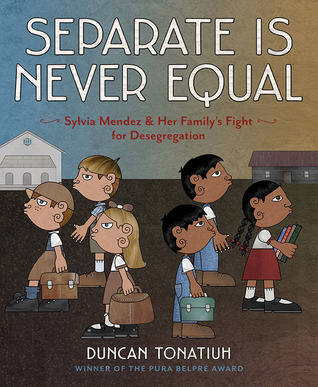Informational Books (Week 4)
Unspeakable: The Tulsa Race Massacre
Weatherford, Carole Boston. Unspeakable: The Tulsa Race Massacre. Illustrated by Floyd Cooper, Carolrhoda Books, 2021.
This is a nonfiction picture book about the horrifying history of the Tulsa Race Massacre and the once-great Greenwood neighborhood. Weatherford decided to write about this story due to her own family's history of facing racial violence. Cooper's grandfather also talks about his time in Greenwood and gives Cooper a first-hand account of the massacre during his youth. The writing style gives the book a fairy tale feeling by repeating the phrase "Once Upon a Time" at the beginning of each page. It's used to tell the story of Greenwood as the magical, once-in-a-lifetime place it was; where Black people could prosper, get amazing healthcare, and a great education. But once the horror starts, the phrase is only used one more time to tell about the devastating violence that the community faced. Because the phrase "Once Upon a Time" stops repeating when the story becomes violent, it assists in showing the change in mood in the book.
There aren't any reference aids in the book, but since it's framed as a narrative, it is not needed. The author's note at the end of the book shows images of the time and the memorials put up in recent years. It also includes a link to a discussion guide about the Tulsa Race Massacre. There aren't any source notes, though Cooper does have stories from his grandfather about his experience in Tulsa.
Camp Panda
This is a book about the preservation efforts of Pandas by the Chinese Conservation and Research Center for the Giant Panda (CCRCGP for short). This is a book about why some species need assistance to be preserved, the preservation efforts of the CCRCGP, and some arguments against preservation. The writing style is formal and informative. While it lightly discussed all animal preservation, it primarily focused on pandas. The images help visualize the work the CCRCGP was doing. Some photographs show the experts in panda suits handling panda cubs. The book explained that this was necessary so the cubs wouldn't become acclimated to humans and couldn't live in the wild.
Camp Panda has around 90 pages in ebook form and includes a prologue and nine chapters. The book includes a glossary, an index, and a table of contents. There is a list of sources at the end that includes a list of experts who were interviewed by the author with their photographs, books, videos, and digital resources. Given the work done by the author, it is safe to say that this book is factually accurate.
Fry Bread
Maillard, Kevin Noble. Fry Bread: A Native American Family Story. Illustrated by Juana Martinez-Neal, Roaring Book Press, 2019.
This is a book about the history and making of fry bread. There are two halves of the book. The first half is a picture book describing the sound, smell, feel, and history of fry bread. The second half includes a recipe and an author's note that tells the author's own history with fry bread. The author also gives more detail to the first half with each section of the author's note mirroring each page of the picture book. The author also gives more detail about each choice of illustration. The author notes that while fry bread can be flat and circular, his aunts taught him to make the bread into funny shapes and it's shown through illustrations. Another note about the illustrations is that they show how diverse native communities are. Each character drawn has different skin tones and hair textures.
There are source notes at the end. The source notes are primarily for the second half of the book as the author directly cites facts from the references. Given that the book is about the author's ethnic background, own lived experience, and research, it is safe to say this book is accurate.
Separate is Never Equal
Tonatiuh, Duncan. Separate Is Never Equal: Sylvia Mendez & Her Family’s Fight for Desegregation. Abrams Books for Young Readers, 2014.
This is a biographical picture book about Sylvia Mendez and her family's fight to have schools be desegregated. Sylvia's family sued the Westminster School District due to them discriminating against Mexican families and forcing their children to go to an inferior school. The case exposes the racism of the school district as students of the Mexican schools come to the stand and speak perfect English and the superintendent expresses his belief that white students are superior to Mexicans. Although Sylvia doesn't take the stand, her experiences at the school, her family's fight, and her time in the courtroom are centered in the story. The author's note shows that this book was written because the case Mendez v. Westminster School District is not often taught in schools even though it's important to the overall fight against segregated schools.
There is a glossary, bibliography, and index at the end of the book. The bibliography includes an interview with Sylvia Mendez, transcripts of the Mendez v Westminster School District cases, books, articles, and websites. Due to the author's research and relaying of the story of Sylvia Mendez, it is fair to say that this book is factually accurate.





I'm sorry this is late. Playing a little catch up since a couple of these books were hard to come by.
ReplyDeleteNot to worry. That is part of the reason you have choices in the books each week and that the assignment isn't graded until the end. Remember to work for a 40/60 split between summary and evaluation in your formal reviews.
ReplyDelete